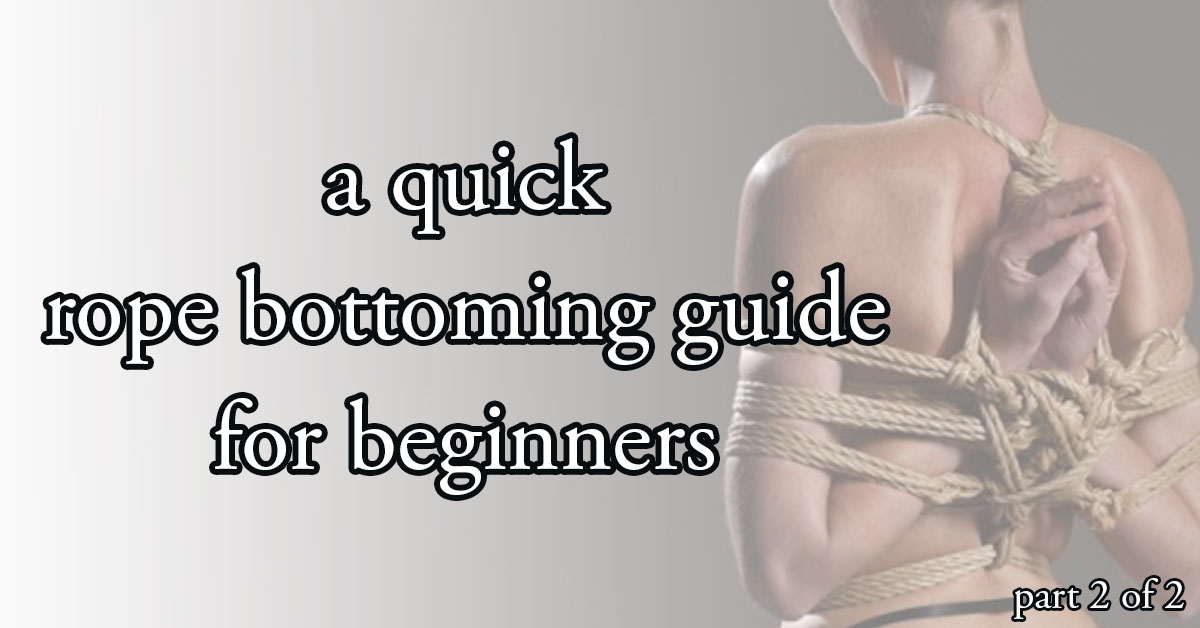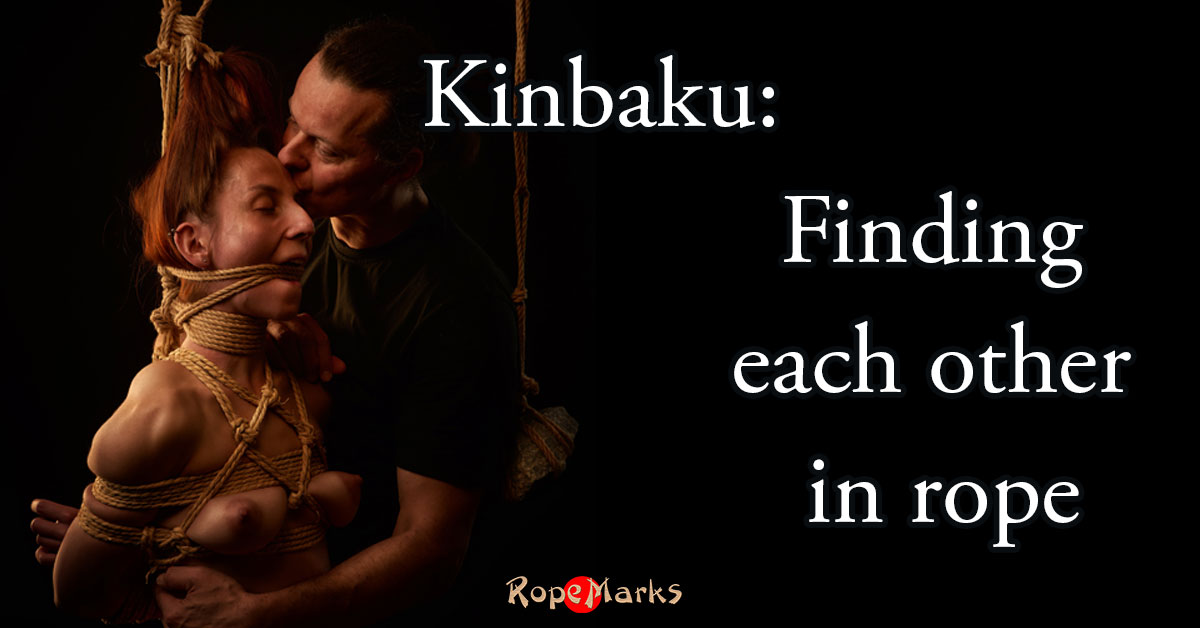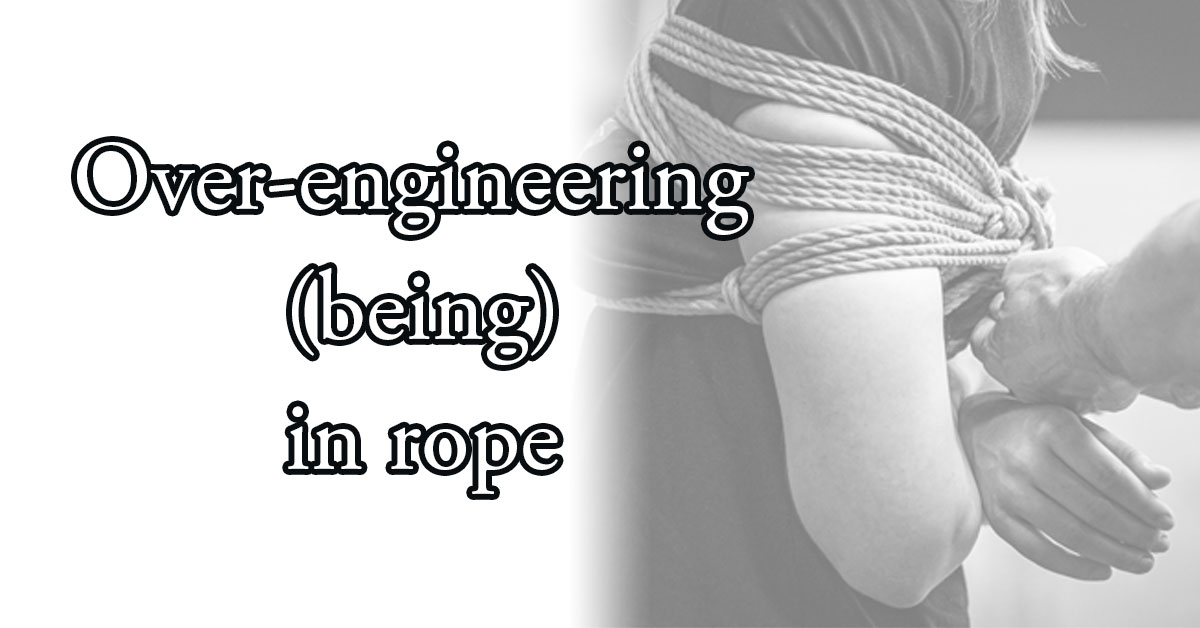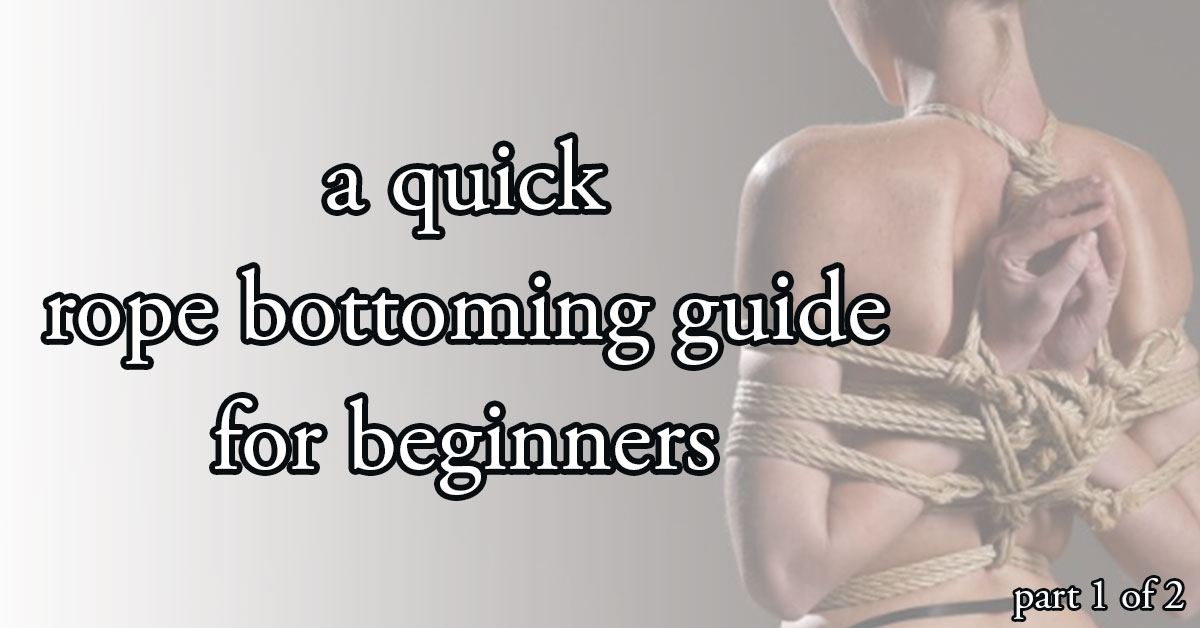What should beginning (or aspiring) rope bottoms know? This quick guide aims to present some answers to that question. It’s based on my personal experience of when I just started getting tied, and on the things I wish I knew looking back now. No (wo)man is an island, so my view isn’t formed in a vacuum: it’s based on conversations I had with rope bottoms and riggers, on co-teaching rope workshops (as a model) for beginning and more advanced rope students and on my observations at rope jams, performances and workshops. I am not claiming that I know it all, nor that this guide is complete, but I do believe it can provide a good starting point for beginning or aspiring rope bottoms.
This guide is mostly written for rope bottoms entering the rope scene, and not for rope bottoms who are tying with a previously known partner, even though they might take something helpful from this guide as well. In part 1, I will mention some pointers to take into account when making your way into rope or the rope community. In part 2, I will mention some pointers for the moment that you are in rope, both from a mental and practical perspective. Feel free to take whatever you liked from this guide, and ignore what you did not. In the end, what you want to get out of rope is highly personal, and nobody can tell you what you should like, or how you should do it.
Communication in context
It’s good to be aware of the fact that your communication abilities are always contextual. You communicate differently (and probably more openly) with your best friend than with your boss, a stranger or a rigger with whom you haven’t had a lot of contact before. That’s why it’s a good idea to reflect on your own perception of the person you are going to tie with. As a beginning rope bottom, it’s possible that you feel intimidated by a rigger’s rope experience, gender, socio-economic status, position within the rope scene or age, even if you do not consciously experience a feeling of being intimidated. This can make it more difficult to communicate openly with your rigger, and it can also make it more difficult to be honest with yourself about what you are feeling. It’s furthermore likely that you feel nervous and anxious about the first time being in rope: I for sure was extremely nervous the first time (actually the first few times) of getting tied!
All these things combined result in the fact that it is quite common for first time rope bottoms to surpass their boundaries (which irresponsible riggers sadly can exploit). It’s of course not like that for everyone, but I do think it’s fair to say that it is a common pattern. Being in rope also means putting yourself in a vulnerable position. That doesn’t mean that all you can be is just a helpless rope doll: there are many things you can do to empower yourself and increase the likelihood that your time in rope is empowering, pleasurable and as safe as possible.
One of the things you can do is to reflect on your general communication style, as well as the way that you perceive your rigger. If you are neurodivergent and have specific triggers or ways of communicating, it’s a good idea to share that with your rigger so you can together find ways of communication that are helpful to both of you. If you aren’t neurodivergent, it’s still useful to reflect on your communication style. Are you a people pleaser and do you find it difficult to say no? What are your fears in being tied? Are you worried that you are boring as a rope bottom (which is quite a common worry)? Are you worried that you might not be able to handle enough pain, that you are not flexible enough, or that you are not ‘attractive’ enough for your rigger? If so, are you afraid that they might never want to tie with you again and reject you, and are you therefore presenting a version of yourself that is not really you? These questions can of course not be answered completely before your first rope session, but thinking about them (and talking about them with your rigger) can help to make you feel more calm and take active responsibility for your own experience and safety in rope.
That’s also why my advice would be – but this is quite personal, so you might disagree – to tie with the same rigger(s) regularly, especially at the beginning of your time in rope. This can help to better ensure that you feel emotionally safe enough to be honest and talk about anything you should be able to talk about. This advice of course has the risk that if you are tying with one rigger who does not have your best interests in mind, you start to normalize unhealthy practices in rope, which you might have found out about if you would have tied with multiple people. So, no matter how you approach your start in rope, never ignore your gut feeling, read advice on rope bottoming, talk to other rope bottoms and riggers and start rope in a way that feels the most safe and comfortable to you.
Communicating before, during and after rope
Communicating before a rope session
Some of the topics you should discuss with a rigger before tying, especially if you are a beginning bottom, are:
– Your past experience as a rope bottom;
– Past and present health issues such as injured or strained body parts;
– Mental health challenges, neurodiversity, emotional issues or certain types of subspace that could play a role in your bottoming (ex: past trauma, ‘spacing out’ and going non-verbal, triggers);
– What you will be wearing during the session;
– Whether you will use a safeword, and what that safeword will mean in the moment;
– What body parts are off limits to be touched by the rigger;
– Whether the rope scene will be sexual or not (and what sexual means to both of you);
– Whether pictures (with or without face) can be taken and posted online;
– What kind of ties you will be doing (ex: will there be suspensions or not?);
– Your knowledge of nerve damage;
– Your expectations of aftercare.
On a more positive note, it’s also important to be clear about your wishes, and not only about potential problems. What has drawn you to rope? What kind of experience are you hoping for? Sharing this with a rigger will make it more likely that you will have a satisfying scene and is also a way to see whether you and your rigger are on the same page when it comes to having satisfying rope experiences.
Some practicalities to take care of before a rope session are:
– Going to the bathroom;
– Having eaten something light recently, but not feeling overly full from heavy food;
– Having drunk enough water throughout the day;
– Being in a good place generally (feeling well rested, not overly stressed and physically fit). Note: your menstrual cycle (if you have one) can greatly influence how you feel in rope.
Communicating during a rope session
I have one piece of advice: TALK! I cannot stress this strongly enough. Being in rope for the first time can be an overwhelming experience, which can make it difficult to talk and communicate. However, constant communication in rope (especially when you are a beginner) is one of the main ways to make sure you will have an enjoyable experience. That doesn’t mean you should be talking about the weather or your weekend plans: it’s about communicating when rope feels uncomfortable, when you experience bad kinds of pain (more on that later), when you feel different sensations in your hands or feet such as numbness or tingles (more on that later), when the rope feels too tight and when you are in any kind of discomfort that you are unsure about. In quite a lot of cases riggers can for instance run their finger past the rope, and by moving it mere millimeters it can make a world of a difference in how the rope feels to you.
Also, it’s very nice to share the positive things you are feeling with your rigger when in rope. It’s not something that all bottoms seem to do, but in my experience riggers love to hear positive feedback on what they are doing (they are human after all). You can for instance tell them how certain ropes or a certain position makes you feel (ex: I love how tight/restrictive/sensual/challenging this position is) or you could tell them how you are feeling in general in their rope (ex: I feel so good/beautiful/strong/sexy/capable/seen in your rope).
However, it is important to note that it is ALWAYS okay to ask to be untied for any reason. If you don’t feel comfortable anymore (mentally or physically) you should ask to be untied. There is no shame in that. And if your rigger makes you feel as if there should be shame, this rigger is not somebody you should be tying with.
Personally, I am not the biggest advocate for only using safewords in rope. I think that rope is a kind of kink where constant communication is necessary, and not only at the moment when you would use your safeword and shit has already hit the fan. When it comes to impact play for example, one wrong hit can cause an instantaneous kind of bad pain which means that the scene needs to be stopped (or paused). So in that case, a safe word is very helpful. When it comes to rope, it is more likely that bad kinds of pain are building up slowly over time. And at times, when anticipating your body and the rigger’s tying (which again is a skill that develops over time), you start to learn how to communicate early on, to mostly avoid pains that are too challenging to handle which leads to stopping the scene.
However, I also know that for others safewords work in rope because they see it as a concrete tool to stop the scene at any time. It’s again up to you and the rigger to decide whether you will make use of one or not, and if it helps you feel safer during your first times in rope, I would advise you to use one. As long as you don’t see a safeword as the only time you should be in communication during rope.
Communicating after a rope session
You have probably beforehand discussed some ideas with the rigger on what you would like to happen after the rope session is over. Some people love to cuddle up with their partner, some prefer to be left alone, some need time to come back to their usual headspace and some people are back on their feet right away. When you feel like you have recovered from the scene, it can be nice to reflect with the rigger on what went well, on what you had doubts about and what did not go so well during the session. For some people it works better to do this a few hours (or a day) after a session, and for some people this kind of reflection is not necessary at all.
From a practical point of view, it’s a good idea to have a sweater or blanket nearby (because you can start to feel cold when coming out of rope) as well as some water and a sugary drink or snack.
Nerve damage & blood circulation
I am not a medical professional, so please do not see this as medical advice. If you have suffered from nerve damage you should always consult a doctor. Nerve damage is one of the most common physical dangers of rope bondage. Technically it (very roughly) means that when too much pressure is applied to a nerve vessel for a long period of time – which can easily happen when in rope – the nerve vessel can be damaged and thereby put strain on the actual nerve. When that happens, it can lead to a loss of movement (temporarily or in the worst case permanently) in your hands or fingers, or to a numb feeling in the skin. It can also lead to wrist drop, meaning that you are unable to lift your hand anymore. These are consequences that can last for several hours, days, weeks or months. In rare cases, the loss of sensation or strength in the arms and hands can be permanent. As a rope bottom, you thus have a big responsibility to communicate about warning signs of nerve damage with your rigger.
Warning signs for nerve damage are partially personal, and it’s sadly just as possible to get your nerves damaged without you experiencing them. There are however some things you can do as a rope bottom to reduce the risks.
Any sensations – especially in the hands and fingers – that are different from the everyday feeling in your hands should always be communicated with the rigger. Common examples of different sensations are feelings of numbness, feeling as if there is static noise/snow on TV, feeling as if your hands or arms are asleep and tingling sensations. If you experience any of these, tell your rigger immediately, and try to be as specific as possible. You could for instance say: I start to feel tingling sensations at the top of my pinky finger of my right hand. Or: it seems like my whole left hand is slowly starting to feel numb. Your rigger has two main options at that point: they can either slightly move the rope to see if the sensations in your hands quickly return to normal. The sensations should (in my opinion) return back to normal within 10 seconds. If that’s not the case, they should either untie you, or if the rigger is skilled enough, transition you to a position where there is no pressure on the hands anymore.
Nerve damage vs. loss of circulation
Nerve damage can feel somewhat similar to a loss of blood circulation, which is a lot less likely to lead to serious health problems. The problem is that when your blood circulation is impeded, it’s much more difficult (and for me personally impossible) to feel whether a nerve might be pinched at the same time, because the feeling of impeded circulation tends to be dominant. That means you are taking serious risks by continuing a tie when you experience a loss of circulation, which is why I would strongly advise against it, especially when you are a beginning rope bottom.
The difference between nerve damage and loss of circulation is that nerve damage is usually felt in a very small area (ex: two fingertips, a small patch on the hand or one finger) whereas circulation loss usually covers the whole hand rather equally. Circulation loss tends to be gradual, whereas nerve damage can both be gradual but also very sudden. However, it’s really difficult to come up with these common denominators, since what you will feel (or not feel) is dependent on your particular body.
Self-checks you can do
Besides being aware of the feelings that you have in your fingers and hands and communicating about them, you can also do some checks by yourself when in rope. Are you still able to make a fist out of your hand? Can you still flex your hand to the back? You can also touch each fingertip with the thumb of the corresponding hand to check whether all sensation has still remained in the hands. You should also still be able to squeeze the hands of your rigger with your regular strength, so you can also ask whether you can give them a little squeeze in their hands.
For a more extensive overview of the location of the nervous system in the body and other nerve checks you can do: see this guide.
Good vs. bad pain
I am (still) not a medical professional, so please don’t see what I am saying here as medically valid knowledge. I am speaking from my own experience and from what I have learned through conversations with other rope bottoms. The difference between good and bad pain is for a very big part personal. Each body has different sensitivities and different pain thresholds, so in the end, it is up to you as a rope bottom to decide whether a sensation is too painful for you. Some people love to have a rope in their waistline, others find it unbearable. Some people love rope pressure on the chin bones (for instance in futomomo) and others hate it. It all comes down to listening to your own body, and the kinds of sensations you want to and can endure even change depending on the day.
There are some clear cases of bad pain that you can be mindful of such as: pain inside the joints, twists in muscles that feel uncomfortable, unintentionally inflicted sharp and stinging sensations and pain inside your organs. You should also be extra careful with painful sensations in the neck and head area.
Other sensations that you should communicate to your rigger are dizziness, nausea, the feeling that you might faint, cold sweat and intense pressure on your head (as if it’s about to explode). They aren’t necessary or normal experiences of being in rope, and they especially aren’t when you are just starting out. Over time you can gain a better understanding of your own body in rope and its reactions. But at the start of your time in rope, I would suggest not to do that yet: any kind of bad pain or unpleasant side effect should be communicated straight away with your rigger. It’s better to say too many things (at the beginning) than to leave out important warning signs that could cause you unpleasant experiences in rope, or in the worst case, (semi)-permanent harm.
The only one who feels what is happening in your body is you (and not the rigger).
If you are uncomfortable in a certain position, even if you are unsure whether it’s a ‘good’ or ‘bad’ kind of pain, communicate with your rigger and stick your ground. Don’t let them tell you that this pain is something you should enjoy. It could just as much be bad rigging from their side. So don’t think that rope bottoms should just suffer through anything because that is an essential part of rope bondage. If you don’t like what you feel, you simply don’t like it. Rope bondage is not meant to cause pain, unless explicitly negotiated and intentionally inflicted by the rigger.
Common beginner ‘moves’ before, during and after a rope scene:
– Ignoring your gut feeling and not acting on it due to group pressure, wanting to be liked (by a rigger or rope community) or being nervous and therefore potentially being stuck in a people pleasing or fawning mode;
– Not speaking about your state of mind and body of that particular day to your rigger;
– Not speaking up in cases of bad pain or doubt about sensations in your body;
– Not speaking about what you would like to experience as a rope bottom, thinking the rigger ‘knows it all’ and ‘should decide’ because they are the ‘dominant’ one;
– Being afraid to ask to be untied for any reason;
– Sticking to tying with a certain rigger even though they have crossed your limits or have not really listened to your feedback;
– Not asking a rigger about their own needs, limits and wishes for aftercare;
– Thinking that recurring nerve damage is a normal part of being a rope bottom. To clarify, I don’t mean to understate the risk of nerve damage for rope bottoms. The risk is very real and since we aren’t rope robots but human beings, human mistakes – in communication and in tying – will be made. That shouldn’t imply that regularly getting nerve damage is part of rope.
To wrap up, I should emphasize that these are not just mistakes that beginning rope bottoms make. They are ongoing points of attention for more experienced rope bottoms as well. Being in rope is a continuous learning process, where you will always encounter ups and downs, good and bad days and new discoveries about yourself and your partner(s) in rope. So don’t beat yourself up for not being perfect and making mistakes. I hope this guide did not scare you away, but has made you feel better informed and more excited about how to approach being in rope as a beginner.
Additional sources
Other sources that contain more detailed information are Somatics for Rope Bottoms: 12 embodies inquiries for transforming your experience in rope bondage by Natasha NawaTaNeko, The Little Guide to Getting Tied Up by Evie Vane and A guide for Rope Bottoms & Bondage Models by Clover (which can be downloaded for free in English, Dutch and other languages here). Another source that can be helpful specifically for rope bottoms whose bodies do not conform to the norm is Better Bondage for Every Body by Evie Vane.
Part 1 | Part 2 | the Shady Lady | RopeMarks Ryu | RopeMarks












Leave A Comment